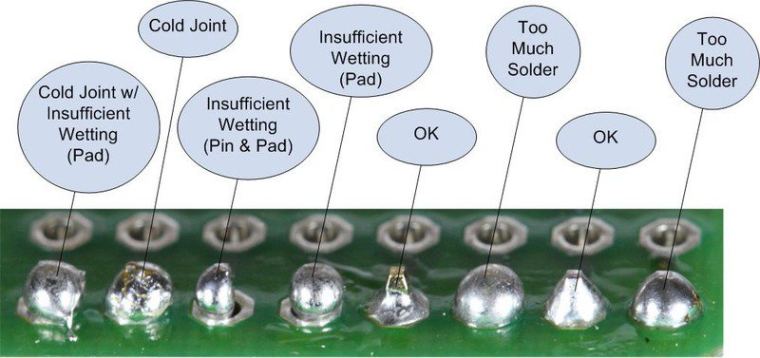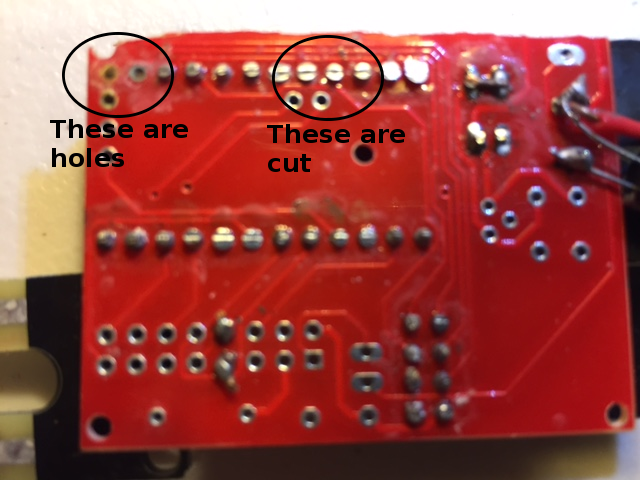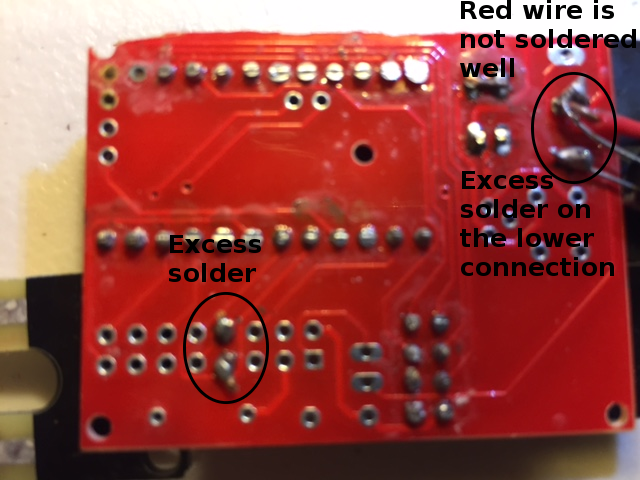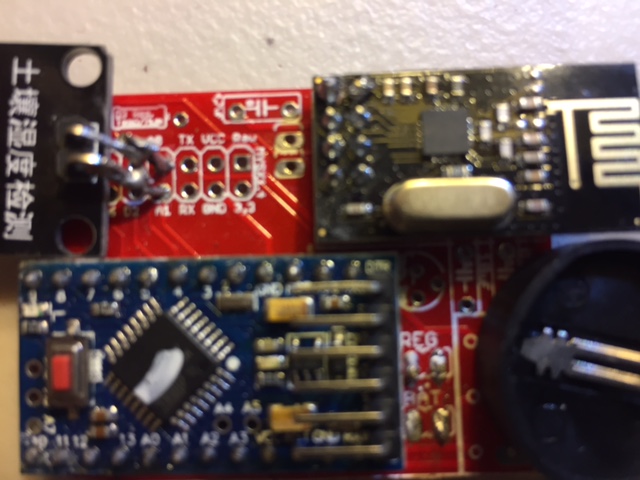Board and hardware failures
-
Re: Easy/Newbie PCB for MySensors
Over the course of months using the boards, I'm up to 4 boards that I have had to "put aside" due to hardware problems. Maybe the radio is bad, maybe the pro-mini, maybe the board itself. I have been waiting for a day when I would try to recover what I could. My last failure was the most aggravating - I tested the radio, tested the pro-mini - everything was OK. Then I soldered them onto the newbie board, and I get the rolling:
0 MCO:BGN:INIT NODE,CP=RNNNA---,VER=2.2.0-beta 49 TSM:INIT 65 TSF:WUR:MS=0 81 !TSM:INIT:TSP FAIL 114 TSM:FAIL:CNT=1 131 TSM:FAIL:DIS 147 TSF:TDI:TSL 10174 TSM:FAIL:RE-INIT 10190 TSM:INIT 10223 !TSM:INIT:TSP FAIL 10256 TSM:FAIL:CNT=2I assume a connection to the radio is bad. It would be better if I always used female headers so I could swap out boards - but it makes the package so much bigger - I don't like them.
I'm looking for tips for avoiding problems, and how to recover boards.
Should I try to de-solder the pro-mini first? The radio?
Is it possible my soldering iron is too hot?
Should I test the newbie board before using it?
Are there any tips for diagnosing connection problems on the board, or identifying what is bad?Thanks ahead of time!
-
It is kind of odd that the pcb fails. Did you check continuity between radio pins and arduino pins?
-
@ileneken3 - Hi!
Sorry to hear you are having problems. You should not need to test the PCB but who knows, might be a bad batch?
What kind of hardware are u using besides the radio and pro mini? Any DC/DC booster involved? This is the only time I have had problems using the board. Are you using Rev 6-8? (If you do, make sure you connect the ground properly on the capacitor on the radio - the G that marks ground is wrong!). I would guess everything is connected atleast since you are getting to this debug. If any connection was broken it would say something else.I have made a setup board to test my hardware before putting them into place on the board. Using this method for atleast 15 nodes have worked out great for me. I hope we can help you figure out this problem.
Do you have any Pictures that might help us help you?
-
@ileneken3 and @sundberg84
Hi!
I agree with @sundberg84 , the only time I have had problems, and that is only once, is when I had a very noisy DC/DC booster connected. It took an extra 22uF capacitor at the output of the booster to get the radio to connect to the GW. The booster generated spikes of more than 150 mV peak. I connected the capacitor in the experimental area where Vcc and GND are available. I also switched the capacitor close to the radio to 22uF instead of 4.7 uF. For my next design, I will make sure to connect the radio directly to 2xAA as suggested many times
-
Hello everyone:
I took Gohan's advice and did the continuity tests. On two of the boards I tested, there was a lack of connectivity to pins 10 and 11. (Pins 9,13, and 12 were fine).
These boards were from two different batches.Below is a picture of a board that was actually working for weeks. Then I get the same !TSM:INIT:TSP FAIL failures rolling out. Since this was a plant moisture sensor, I assumed it was because I got some water on it - but maybe not.
On one of the boards, I de-soldered the radio. Then the continuity was even worse. I don't even want to show a picture of it

So - does this provide more clues? Any idea on the best way to salvage parts now? I have a feeling the pro-mini is just fine.
Thanks again!
-
Could it be that you damaged the tracks during soldering? If you don't have continuity you could just bridge the the pins with small cables, it's not very nice to see but at least you can still reuse the board without desolder the components
-
@ileneken3 - well its really odd that the tracks should be damaged! Never seen that - but hey first time for everything.
Do you see any damage or exposed copper where you cut the PCB (between prototyping area and main board?) The board and pin in the upper left corner looks badly damaged and without conductive material- is this pin 10? Pin 11 looks damaged as well.
I find it very hard to salvage parts, (probably bad desoldering skills) and I would just add wires where the tracks are broken and use the board. (Edit: Like @gohan said).
Your radio (without silkscreen markings) could be really bad fake versions. I have unfortunately seen some posts about these and this can also be an issue (unless they worked before you soldered them on - with the same range as live). I have some of these and they work on the bench a couple of meter from the gw but are useless when you get some distance away. To be clear I have also had radios with the silkscreen which performed OK!
-
when buying chinese parts, it is always good practice to use female headers on pcb for easy swap

-
I am enclosing a picture of my attempt at a "workaround". Someone might get a good laugh out of it!

This was a bit of a challenge to do - and it STILL doesn't work. I measure continuity with all the right pins, but I probably damaged the board. This should have been the first thing I did.
In answer to all the questions:
- I don't think the tracks are damaged, and there was nothing left exposed when cutting off the right side.
- I tested the parts before soldering them on, although that doesn't mean they couldn't go bad later.
- I will be using female headers the next couple of rounds. I just wish they weren't so big.
- I have been watching YouTube videos about de-soldering. It will be a project for another day.
I appreciate the help. Hopefully others have learned from my experience! I will report any other interesting findings.
-
Your pictures from your original post are a bit blurry, but pins 10 and 11 don't appear to come through to the bottom side of the board, and you solder joints don't look the best. Not sure why those pins aren't coming through the bottom side of the board, but that could be a major part of your problem. The traces that connect them to the radio are on the bottom side, so if there is not a good solder connection there, you will most likely have issues. Especially if the through hole plating is damaged in any way.
Suggestions:
- Use some flux and your soldering iron to clean up those solder joints. You may need to use some solder wick, or even a bare piece of copper wire with some flux on it to remove excess solder from your joints if it doesn't wick away with the tip of your iron.
- When soldering, apply heat to both the pad and the lead coming through the hole for a second or two, then apply the solder, then remove the iron. Don't hold the iron on the pads for extended periods as you can damage the pads.
- Use a small chisel tip rather than a conical tip. You will get better heat distribution when soldering. Hold the flat part mostly on the solder pad and touch the protruding wire when soldering.
Here are some examples of good and bad solder joints:

MAKE SURE that the tip of your soldering iron is clean too any time you are going to touch it to the board. A dirty iron tip can cause some of the issues shown above. If your tip looks anything like this, GET A NEW ONE:

Here is an example of before and after wiping your tip when soldering:

Hope that helps.
-
In the blurred picture it seems more if he trimmed the headers and also some solder in the process.
-
@gohan said in Board and hardware failures:
In the blurred picture it seems more if he trimmed the headers and also some solder in the process.
Not for 10 and 11, it looks like there are holes in the board in those two spots. The rest of them look like they are cut/trimmed.

Also, look around pins 10 and 11 and a few other spots on the board. The board is really dirty like excess flux residue. That should be cleaned with alcohol.
-
@dbemowsk is right here, pins 11 & 12 are not connected to the PCB.
I've had hardare problems with PCBs only with one batch from one maker and after desoldering, if you don't severely overheat the board or apply excessive mechanical force you will not have problem, as they are all electronically tested at the end of the production process and they only send you the boards that pass the test.
And desoldering things like pro mini or nrf24 is a real pain, most of the time you will damage them and just waste your time.
What I do now is I unsolder the parts (mainly atmega, capacitors) on the promini using my hot air gun as it's fast and I can reuse them in SMD projects. But full ProMini and through hole NRF 24 I have given up, not worth the time wasted when you see the price on AliExpress...
-
Here are a few more things to point out:

-
@Nca78 Years ago I bought this desoldering iron from Radio Shack. This thing works great for thru-hole components as you can heat up the pad and lead with the tip and suck it away right away while it is hot. I have had a few troubles on some things, but overall it has worked well for me.

-
Clever design, a little bulky for my personal taste: I'd have preferred a spring loaded mechanism
-
@gohan I have one at work that is a pencil type like the old plunger type solder suckers, but that one doesn't seem to work for crap. What can you expect for $8 bucks. The only reason I bought it was because I knew how well the one I had at home worked, and I thought this might do a similar job.

-
I hate desoldering, that's why I try to avoid it as much as possible


-
@gohan I am with you my friend, but there are times when necessity gets in the way of that.
-
@ileneken3 said in Board and hardware failures:
Since this was a plant moisture sensor, I assumed it was because I got some water on it.
I'll bet on (galvanic) corrosion as a root cause. Protect the pcb or use wires between pcb and sensor.
-
maybe it got watered too

-
OK, I started over again with the moisture sensor -taking all the advice I got.
- Used female headers, to allow for easily swapping hardware.
- No longer cutting pins on back of the board.
- No longer cutting right side of board off (in case damage is done).
- New soldering iron tip.
- Soldering with a magnifying glass, and being careful.
- Checking continuity.
- Checking pro-mini and radio separately.
- Separating the "fork" so no soil or moisture touches the PCB (avoiding corrosion).
I turned it all on , and got the same !TSM:INIT failures. Just when I was about to throw the board against the wall, I took a shot at shorting the REG (in addition to the BAT). Then everything worked great!
I guess I don't understand why that worked. I figured I'd write myself a spreadsheet, and fill in the combinations. Attached is my start.
Comments/Corrections?
-
@ileneken3 First and foremostm, don't get discouraged. We are here to help. Can you show us a set of fresh pics of both sides of your board so we can see what's going on? The easy newbie board can have several configurations and depending on how you have things connected with your incoming power will determine what BAT and REG jumpers need to be in place for things to work properly.
-
@ileneken3 as @dbemowsk said, there are some configurations you can use which is tested (see openhardware for details). If you have some insight and imagination thought there are probably a 100 different combination you can do... but also 100 different combination that won't work! (100 might be exaggerated but you get the picture).
First rule - the board is not designed to short both bat and reg at the same time.
BAT and REG as dependent on which input you use and if you use a booster/regulator or not.
About your spreadsheet:- Correct! Should work - what kind of problems did you experience?
- Correct! Should work - what kind of problems did you experience?
- Not possible. Using BAT you can not cut the PCB because the trace runs through the booster module. If you dont want to use the booster you can bypass it with a wire but its not possible using 3x5cm cut pcb.
- I dont know, I have to have a schematics because it depends in which input you use and how you put the regulator. This will feed the 3.3v pro mini with 3.7v directly and only regulate the power to the radio.
You always connect your power source to VCC and never RAW - right?
When you had this issue:
I turned it all on , and got the same !TSM:INIT failures. Just when I was about to throw the board against the wall, I took a shot at shorting the REG (in addition to the BAT). Then everything worked great!
What kind of hardware and power supply did you use? Did you use a tested radio (to exclude radio failure).
Another tip is to solder the basic components first (not any sensor or accuator) and test the board with a easy sketch like timeaware sensor. If that works you can continue to include the sensor to exclude its a sensor error.
The easiest way is to follow the guidelines on openhardware or ask what you want to achieve.
-
@ileneken3 said in Board and hardware failures:
@gohan
!TSM:INIT failures.TSM INIT means radio was not initialized, in that case only 2 possibilities:
- connection problem with one of the radio pins
- radio doesn't get power (it seems that was the case for you)
-
"100 different combinations"
Yes, I meant the spreadsheet to be a list of typical examples - not a comprehensive list. For a "newbie", having a cookbook style recipe is useful.- Works, no problems.
- Works, no problems.
- This is a big surprise. I thought I might have been doing something wrong, but nobody caught that from the pictures I sent! For a plant monitor, where the sensor needs almost no voltage, I didn't think it made sense to use a booster. I also wanted a nice compact device to stick in the plant pot. So, given my "illegal" configuration, I suppose it's no surprise there would be some erratic behavior?
- This works great for me. The board (and most sensors) work fine in the voltage range of a LIPO - only the radio needs to be regulated down to 3.3V. The mcp1700 needs its pins crossed over to work (since the board is designed for a LE33 regulator). A correction to the BOD column would be "2.8V (default)" or "N/A".
I have never used RAW.
Regarding:
What kind of hardware and power supply did you use? Did you use a tested radio (to exclude radio failure).I used 2 AA , a 3.3V pro mini with no BOD. I tested the radios, and even tried different ones. I can send a picture - but there's nothing interesting with it. So, the existing mystery is: why do I need to short both BAT and REG (which I know now is illegal)? I tried all combinations of shorting/not shorting jumpers - that is the only one that worked.
-
@dbemowsk
Yes, I appreciate the help! I am hoping others are learning from my adventures. It wouldn't be a fun hobby without a bit of frustration here and there
I am attaching fresh pictures. The sensor attached is a "fork" for plant moisture monitoring.


-
You could also consider smaller pcbs available on openhardware and maybe using cr123 battery to make it smaller, since it has to go near a plant
-
So, given my "illegal" configuration, I suppose it's no surprise there would be some erratic behavior?
Exactly, there are multiple way for the current to flow.
2 AA , a 3.3V pro mini with no BOD, why do I need to short both BAT and REG (which I know now is illegal)?
Because you shorted BAT first and if you do you have to have a booster or jump this. When you added REG you started feeding the rest of the circuit and it worked. Using BAT you cant cut the PCB or not use the booster.
You said 1 and 2 "Works, no problems."
Du you have it working now, because im not 100% sure what you are trying to achieve.
-
@ileneken3 the board was not designed tgat way you have it in the picture in post above.
If you feed 2xAA and jump BAT you need a booster (or jump this with a wire and lower BOD) .Another way is to use REG jumper, lower BOD and jump the voltage regualtor with a wire (recommended because then you can cut the PCB)
Edit: I updated openhardware.io with this information (look for 3.3V without booster (advanced users!))
Edit2: Might be that jumping both creates the same effect as wire jump booster!! I will look more into that... as I said, the pcb was not designed that way so I have never thought about it but if it works that great!
-
According to the new documentation, my build is now officially approved by you! Of course, it would be interesting to hear what the exact effect of jumping both jumpers is. All I know is that it works. There seem to be a lot of sensors that work fine down to 1.9V, so I would think that this configuration would be useful. (Assuming that reprogramming the bootloader is not too hard - I didn't think so).
So did you consider making the LIPO configuration "official"? So far, it seems that it works fine for me. It is good for when you really want a small footprint and/or your sensor needs 3.3V. Unfortunately, not as long a life as 2 AA, but you don't have to deal with the booster's expense and possible radio interference.
-
@ileneken3 - what i always consider is the Newbie/Easy effect. Im not going to make any harder build instructions because that might scare people off. I want it easy and understandable. Thats the reason im not going to add tutorial how to change bod and stuff like that. I just mention it so people knows it possible.
exact effect of jumping both jumpers is
Well, Its a long story but here it goes (keep along in the schematics maybe?).
BAT activated the circuit to the radio, but not the arduino (if the booster isnt soldered). The reason for that is that the radio works down to 1.9v. The radio is also noice sensitive and 2xAA could be considered very low noice. When you didnt soldered the booster you did not activate the rest of the circuit. REG activates the arduino pro mini circuit and the sensors. This will output 3.3v from VCC to the voltage regulator but since you didnt have any regulator in place the radio didnt get any power. Two different circuit which activated both together via the jumpers and BOD is disabled will work together. Whats important to know is that if you have had a booster or any voltage regulator this setup may have failed!Thank you for adding this discussion so we could find out this way to use the EasyPCB!
-
@ileneken3 A couple things that I should note. I will reference the image below. First, with the capacitor for the radio (red arrow), though it should work the way you have it, there is a designated spot on the board for that cap. That is the spot where the blue arrow is pointing. The right pad has a G marked next to it. That tells where the negative (-) lead for the cap goes. Then you don't have to have it sticking out the side of your board. If you do plan to keep it the way you have it, watch out for the lead marked with the green arrow. It looks like it is close to bridging the terminal next to it.

The next thing I will reference is your BAT and REG jumpers. Looking at the image below, you have the black spacers for your header connections on the bottom side of the board.
These are designed to be on the top of the board. If you look at the pic of the 2 pin header connector, the two short side leads are what go through the top of the board and the black spacer rests on the top and then it gets soldered from the bottom.


When I do my boards, I just take a piece of wire and bridge the BAT and REG as needed for the board I am building since I am typically building a more permanent circuit. You would typically use jumpers like that if you are planning at some point of changing the configuration and may need to remove that cross connect for one reason or another.
O ther than that, it looks like that setup should work, but I cannot see one row of pins from your pro mini as the battery holder is blocking it in the image.
Keep with it. With help you will get better and gain more knowledge.
-
Make sure to doublecheck the G on the 4.7uF cap if you have rev 7 or 8 because it may be wrong. (this is fixed in rev 9)

